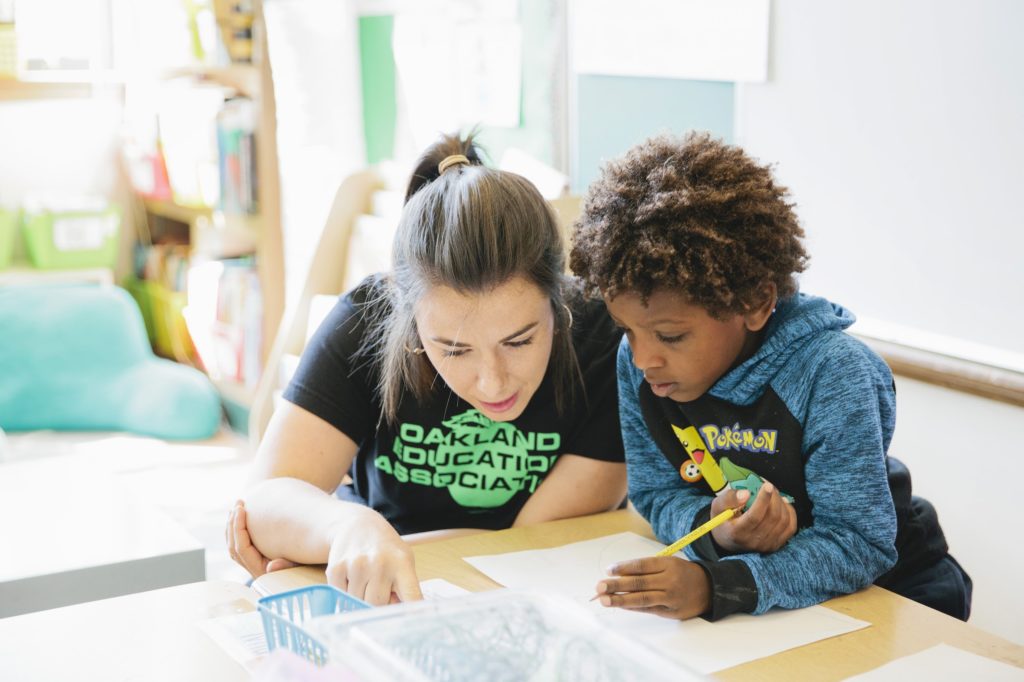Gov. Newsom won’t bend on directing billions to low-income students’ learning loss
 Photos by Alison Yin for EdSource (2017)
Photos by Alison Yin for EdSource (2017)
Reviewing student work at Redwood Heights Elementary Schoolhouse in Oakland
 Photos past Alison Yin for EdSource (2017)
Photos past Alison Yin for EdSource (2017)
Reviewing student work at Redwood Heights Elementary Schoolhouse in Oakland
Gov. Gavin Newsom said Fri he would not compromise with the Legislature on focusing more than $4 billion in federal coronavirus help to accost the learning loss that depression-income students have experienced disproportionately during school closures caused past the pandemic.
Newsom's method of distributing the bulk of the money exclusively to districts with large concentrations of "high-needs students" — English learners, low-income, foster and homeless students — has get a indicate of contention. Senate and Assembly leaders jointly proposed spreading the money widely among more districts in their alternate version of the state upkeep that they released Wednesday.
Just in rejecting the Legislature's proposal, Newsom cited new research by McKinsey & Visitor projecting that black students would return to school this fall even farther behind than they had been compared with other student groups.
"We are committed to the cause of equity. And that'southward the reason nosotros put that $iv.4 billion in the budget to focus on disinterestedness," he said during Fri's press conference on how his administration volition respond to longstanding disparities in wellness, kid care, incarceration and teaching between blackness students and other educatee groups.
"You tin't just spread that money out as. We demand to concentrate its focus," he said. "And I just want to make that clear as responsibly and respectfully as I tin can to the Legislature: I won't budge on that upkeep proposal."
Newsom plans to directly the ane-time federal money under the Coronavirus Help, Relief and Economic Security (CARES) Act that Congress passed in March to remediate learning loss. Of that, $1.5 billion would go to schools based on their enrollment of students receiving special education services.
Legislators and groups representing school districts don't oppose the governor's program. They disagree with how the $two.9 billion would be distributed — only to those districts where at to the lowest degree 55% of students are loftier-needs. Those districts receive actress "concentration" funding under the state's Local Command Funding Formula.
EdSource estimates that those districts would get $754 for every educatee, not just high-needs students. Nigh of the country's 324,000 blackness students, who comprise 5.3% of the country's students, attend those districts, including Los Angeles Unified. Even so, those districts with less than 55% of high-needs students would get no CARES Human action aid.
Legislators object to establishing a funding cliff with distinct "winners and losers," including districts where low-income students make up a majority only not quite 55%.
"Leaving out huge numbers of poor kids is misguided," said Kevin Gordon, a Sacramento-based school consultant. "They are the aforementioned chocolate-brown and black kids the governor is concerned most."
The joint legislative understanding calls for dividing the $2.ix billion based on the Local Control Funding Formula. It sets a base rate per student for all districts, plus additional "supplemental" funding for each high-needs pupil and bonus funding for the "concentration" districts.
Since base funding consumes about 80% of the total coin under the formula, the Legislature's per-educatee funding would not be as heavily weighted toward high-needs students.
The Equity Coalition, consisting of civil rights organizations and groups advocating for low-income children, has proposed a compromise that neither the Legislature nor Newsom has embraced. It would distribute money based on supplemental and concentration funding solitary and not cistron in base of operations funding. This arroyo would fund high-needs students while dropping the 55% threshold.
"It's notable that Newsom signaled quite strongly that he is putting a stake in the ground for equitable distribution of the $two.9 billion," said John Affeldt, managing attorney for Public Advocates, a public interest law firm and a member of the Equity Coalition.
Under the weather condition that Congress set with the CARES Deed, school districts would have to spend all of the $iv.four billion by December. 31. They would be able to spend the money on an early beginning to the school twelvemonth, instructional supports, extending the school year, providing intensive bookish help, mental health services and counseling and teacher training for altitude learning.
Because school closures probably will set back near students to some degree, Newsom didn't limit districts' spending to high-needs students; instead he'd fund only districts where they are heavily enrolled.
At the press conference, Newsom noted that merely 10% of blackness eighth-graders met or exceeded standards on the state's most contempo standardized test in math, the Smarter Counterbalanced assessment.
The McKinsey study predicted that school shutdowns from the pandemic could chemical compound achievement disparities and lead more than black and Hispanic students to drop out.
"This could have long-term furnishings on these children's long-term economic well-being and on the U.S. economy as a whole," it states.
Learning loss will probably be greatest among low-income, black and Hispanic students, who would be far less likely to have access to adequate or above-average altitude learning didactics, the written report said.
Assuming that students would non return for in-person school instruction until January, McKinsey projected that black students would endure the equivalent of 10.three months of lost education, compared with half dozen months for white children and 9.ii months for Latinos.
To get more reports like this one, click here to sign up for EdSource'southward no-price daily email on latest developments in education.
Source: https://edsource.org/2020/gov-newsom-wont-bend-on-directing-billions-to-low-income-students-learning-loss/633204